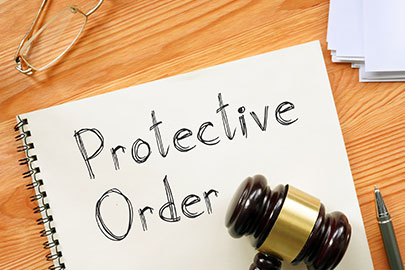
Protective Orders In Texas: The Basics
A protective order is a legal order from a court that’s designed to prevent violence or threats of violence between people in close or domestic relationships. In Texas, these orders can be either criminal or civil. Criminal protective orders often come as a condition of bond after an arrest for family violence. Civil protective orders, sometimes called restraining orders or injunctions, can be requested through the courts, even without an active criminal case.
A protective order can be requested by several parties, including an alleged victim of family violence, a parent or guardian acting on behalf of a child, the district attorney’s office representing the protected individual, or a private attorney filing the request for their client.
Before granting a protective order, the court must determine two things: that family violence has occurred and that it’s likely to happen again. If both elements are proven by a preponderance of the evidence, a lower standard than what’s required in criminal court, the judge has the authority to issue the order.
How Long Protective Orders Last
The duration of protective orders varies, depending on the circumstances and type. Emergency Protective Orders are typically issued after an arrest and usually last up to 60 days. Temporary Ex Parte Orders are issued quickly and without notice to the other party, lasting a few weeks or longer, depending on the judge.
Final Protective Orders are more permanent in nature and typically last up to two years but may be extended in serious cases involving repeat violence, sexual assault, or weapons.
Each order is tailored to the situation, and the judge’s discretion plays a big role in what the order looks like and what it requires.
Do You Have To Leave Your Home If There’s A Protective Order?
Often, yes, many protective orders come with specific conditions that require people to leave their homes, such as:
- No contact, whether verbal, written, or electronic, with the protected person, except through attorneys or a court-appointed third party
- Stay-away provisions from the protected person’s home, school, workplace, and family members
- Firearm restrictions barring you from possessing firearms or ammunition
- Eviction from a shared home, especially if the protected person resides there
If a judge includes those terms, you must comply or face arrest. Even a well-meaning act, like dropping off gifts for your children, could violate the protective order.
Violating A Protective Order
Violating a protective order is a criminal offense. A first violation is typically charged as a Class A misdemeanor, which can carry up to one year in jail and a fine of up to $4,000. If you violate the order multiple times, specifically two or more violations within a 12-month period, charges can be elevated to a third-degree felony. That level of offense is punishable by two to ten years in prison, up to ten years of probation, and fines reaching $10,000.
Can You See Or Contact Your Children If There’s A Protective Order In Place?
Whether or not you can see or get in touch with your children depends entirely on who is protected by the order. If the protective order names only your spouse or partner, you may still see your children. If your children are also named as protected parties, any contact with them could violate the order.
Your attorney can review the order’s specific language and, if appropriate, file a motion to modify it. That process gives you a chance to present evidence, challenge the original order, or argue that circumstances have changed.
Until the order is modified, you must obey it exactly as written, no matter how unfair it may seem.
Case Study : Why It’s Vital Not To Violate Protective Orders
A father who had a protective order against him dropped off Christmas gifts for his kids at his spouse’s front door, a violation of the no-contact clause. He was arrested, and while we were eventually able to get the charges dismissed, he still had to go through the arrest, bond, and legal process. Worse, it dramatically complicated his family law case.
No matter how simple or innocent your act may seem to you, it is critical to comply with the protective order to protect yourself, your case, and your legal interests.
Will A Protective Order Show Up On Background Checks?
Protective orders are civil, not criminal, so they don’t typically appear in standard criminal background checks. However, they are public records, and the existence of a protective order can be discovered in more thorough screenings, especially for jobs involving security, law enforcement, childcare, or government contracts.
Copies of protective orders are sent to:
- Local law enforcement
- The county sheriff
- Any school or childcare facility listed in the order
- The protected individual
While it may not lead to a criminal record, a protective order can still have very real consequences for employment, reputation, and family court outcomes.
Protective orders are serious. They’re not just no-contact suggestions; they’re binding court orders that carry criminal penalties. If you’ve been served one, read it carefully, obey every word, and contact an attorney immediately. Don’t try to reason with the protected person. Don’t explain yourself. And don’t assume you’ll be forgiven later, because even a single misstep can escalate your case to a felony.
Get Your Questions Answered -
Call Us For Your Free, 30 Min Phone Consultation
(817) 678-5080